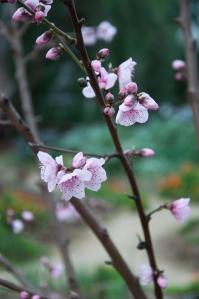The ground is moist, the days are lengthening and all’s well in the garden, at least once some weeding is done and beds prepared for sowing. It’s a busy time in Newstead because our spring is usually short and sweet, but not without the odd frost (keeping gardeners wary about planting warm season plants out too early).
In our climate it’s a good bet to plant seeds in a sheltered frost free spot, under glass or in an igloo, or sunny window sill so that by the time they are ready to plant the frost threat will be pretty much over and the soil temperature warm enough for planting to ensure seedlings will grow on. Many warm season crops eg. tomatoes, capsicums, beans, etc. need at least 20 degrees celcius – constant – soil temperature to germinate and to grow. If you have a thermometer, it’s an interesting exercise this time of year to see what that feels like and how long it takes soil to get – and stay – at that warmth at sowing and growing depth…. So, even though direct sowing is more efficient and produces hardier plants, I’d suggest saving that for later in spring and into summer in our part of the world.
It’s good for planting another crop of leafy greens to get a burst of growth before plants run to seed in the heat – spinach, kale, silverbeet, lettuce, mizuna, broccoli, collards, rocket, endive, chicory, etc. Plant peas, snowpeas, and think about a crop of spuds in a sheltered bed (watch for frost though). Too early for planting seedlings, but try some tomatoes and other summer crops off as seed, under protection of course.
A spring application of BD500 (horn manure) and a feed of seaweed/fish emulsion and/or worm juice are also jobs for this month. As the plants start growing vigirously it’s a god idea to give them a fortnightly feed of well diluted worm juice or other foliar feed. And of course applying compost when you plant and as a topdress (don’t forget your asparagus beds). Pheremone traps out in fruit trees for codling moth and other pests, sticky traps, good bug mix. Don’t forget to check your irrigation and watering systems to ensure they will work when you need them (hopefully) later in the season. Told you it was a busy time of year!
Guide for temperate areas in SE Australia for September 2013:
Leaf Days: 1-4, 11-13, 19-21, 29-30 – bok choi (s,p), kale (s,p), celery (s,p), endive (s,p), mibuna (s,p), mizuna(s,p), orach (s), rocket (s,p), tat soi (s,p), leek (s,p), lettuce(s,p), mustard(s,p), silverbeet(s,p) spinach(s,p), chives (p,s), garlic chives (p), coriander(s,p), dill (s,p), parsley(s,p), rhubarb (s,p), clover (s) NOTE: s=seed, p=plant/seedling
Fruit Days: 4-6, 13-15, 21-24 – broad beans (p) mustard(s,p), peas (s,p), strawberries (p), amaranth (s) bush beans (s), climbing beans (s), capsicum (s), chilli (s), corn (s), cucumber (s), eggplant (s), okra (s), pumpkin (s), rockmelon (s), snopeas (s,p), squash (s), tomatoes (s), watermelon (s), zucchini (s)
Root Days: 6-9, 15-17, 24-26 – asparagus (s,p), jerusalem artichoke (s), beetroot( s,p), carrots (s), celeriac (p), fennel (p), kohlrabi (p), leek (p), spring onion (s,p) salad onion (p), potatoes (s,p), shallots (s,p), radish (s,p)
Flower Days: 1, 9-11, 17-19, 26-29 -broccoli (p), cauliflower (p), borage (s,p), globe artichoke (s,p), sunflower (s)
Other Auspicious Gardening Dates:
Moon opposite Saturn: 23 (a good time to plant, transplant, etc. or 24hrs either side)
Moon Descending: 13-26
Moon Ascending: 1-12, 26-30
Full Moon/New Moon: 19/5
Nodes*: 10, 22
Perigee***: 16
Apogee***: 28
Apply soil food: 20-30
Apply foliar food: 5-12
Mulch: anytime, but watch for frosts (thick straw mulch will intensify them) and remember the slugs!
Transplant seedlings, plants, cuttings: 24-26, then 15-17, 19-21
Graft: 10-12, 26-29
Dates are a guide for these particular crops. Timing will vary from region to region (particularly with climate change) and even within a garden’s own microclimates. Of course, rainfall, weather conditions and your own schedule will influence when you garden.
# Broccoli can be grown year round, apart from the hottest months. I prefer to plant through the colder months to avoid having the broccoli forming heads when the cabbage moth butterfly is active, in late spring and summer.
* Each month there are a couple of ‘node days’ when the sun and moon are in opposition. Many biodynamic gardeners choose not to plant on these days, or at least a couple of hours either side of the node.
** Perigee is the point where the moon is closest to the earth, so the influence of the moon is strongest. Apogee is the furthest point from the earth, so the opposite occurs

